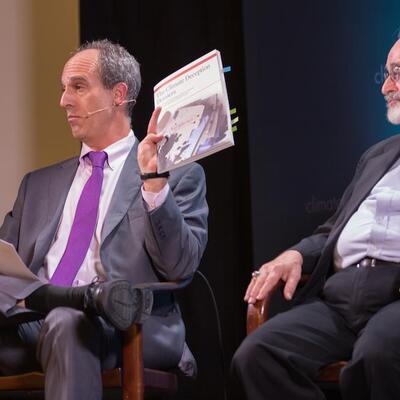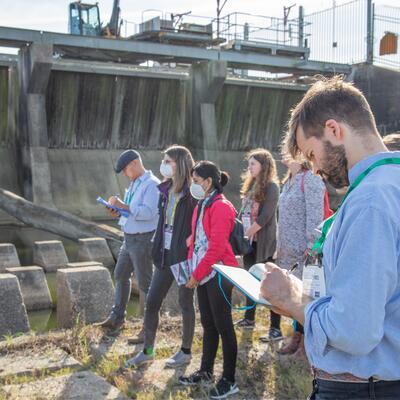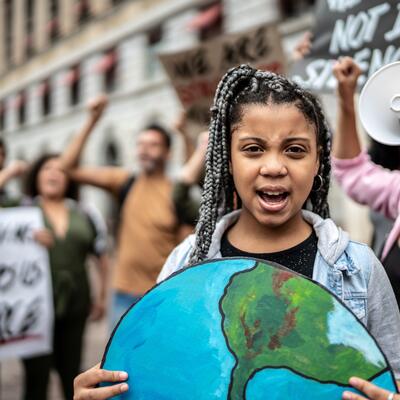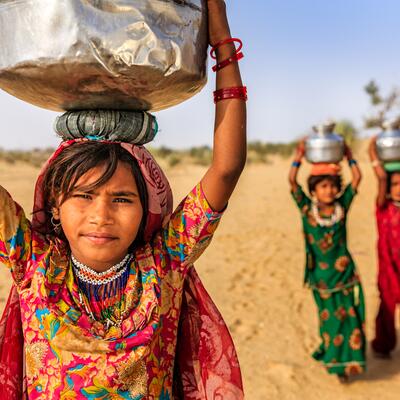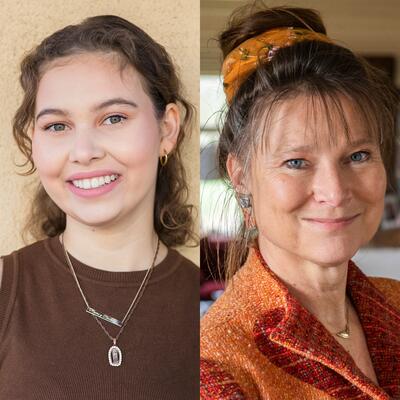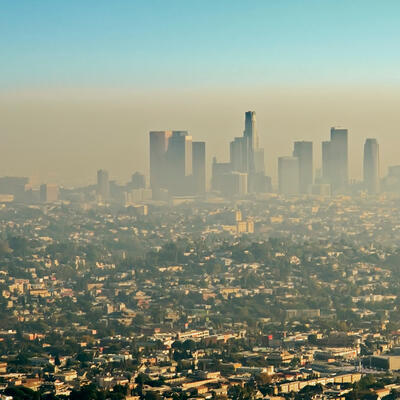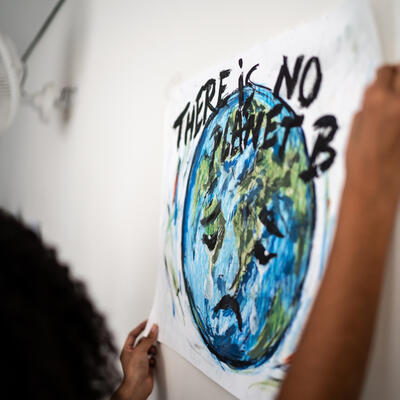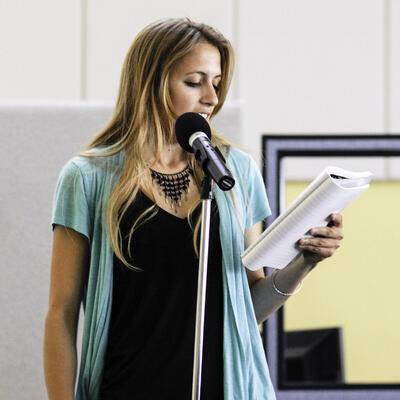
Learning Green
Guests
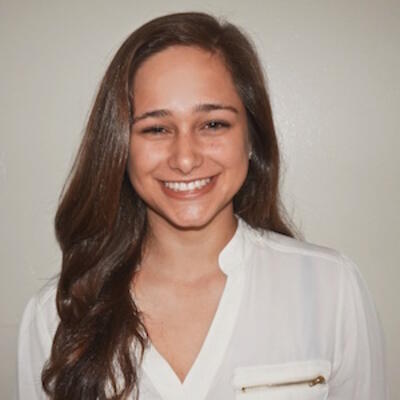
Giana Amador
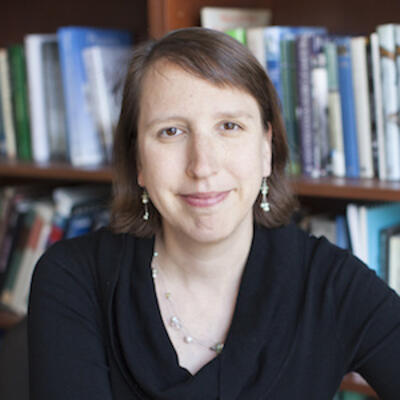
Minda Berbeco
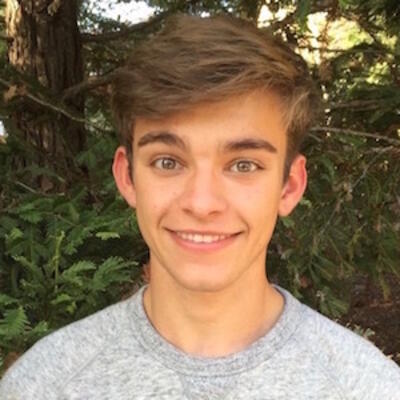
Ryan Condensa
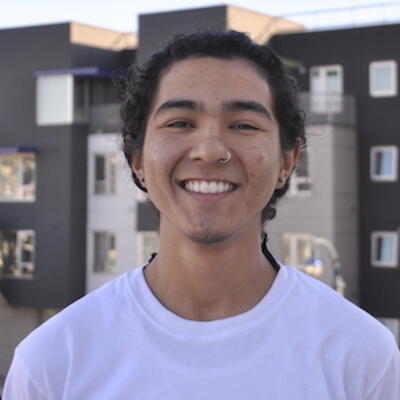
Luis Martinez
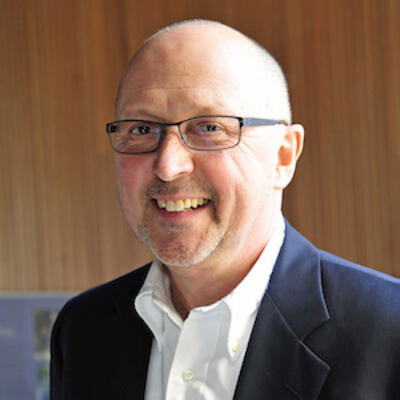
Alexander Zwissler
Summary
We discuss how doctors, teachers and parents are framing climate change as a children’s issue. The American Academy of Pediatrics issued a statement saying children’s health will be disproportionately affected by climate. The California Parent-Teacher Association is raising its voice about carbon risk and the Boy Scouts are teaching kids about sustainability.
Giana Amador, Research Analyst, Center for Carbon Removal
Minda Berbeco, Programs and Policy Director, National Center for Science Education
Ryan Condensa, Action Fellow, Alliance for Climate Education
Luis Martinez, Student Activist
Alexander Zwissler, Principal, Einstellung Labs
This program was recorded in front of a live audience at the Commonwealth Club of California on April 23, 2016
Full Transcript
Greg Dalton: From the Commonwealth Club of California this is Climate One. I'm Greg Dalton. When Secretary of State John Kerry signed the Paris Climate Agreement recently, he held his two-year-old granddaughter on his lap. She probably knows quite a bit about climate change already and today on the show we’ll explore what other kids are learning and doing about climate disruption. In the second half of the hour, we'll hear what three high school and college students in the Bay Area are already doing to act upon what they learned in the classroom. Their knowledge and their action will inspire you and may be make you think about what you were doing at their age. In our first half-hour we’ll learn what teachers, pediatricians and museums are doing to frame climate as a concern for California's children today.
We’re not talking about 2100 here, people. We’re pleased to welcome now two climate education experts. Minda Berbeco is Programs and Policy Director of the National Center for Science Education, a nonprofit based in Oakland. And Alex Zwissler, former CEO of the Chabot Space and Science Center where he led development of the Bill Nye Climate Lab. He’s now a principal at Einstellung Labs which advises educational organizations and museums. Please welcome them to Climate One.
[Applause]
Minda Berbeco, let's talk with you and go to San Diego where the PTA, the Parent-Teacher Association approached you because they were trying to get more education in schools about climate. So tell us when they approached you.
Minda Berbeco: Sure, they were interested in bringing more climate change into their local schools. They saw it as an issue, not just for politicians but one for their classrooms and for students. And they wanted the PTA to step up to do that. So if you have never been to a PTA convention before it's quite an amazing experience. So it's like a political convention but instead of people jostling about the politician they’re gonna vote for, instead they are all advocating for their children's education. So it's thousands of people shouting and dancing and so on. And so they wanted to bring resolution to the PTA to talk about climate change and it was an incredible experience. I've never been around more passionate people.
So they brought it to the convention and there were many interesting conversations that happened with different PTAs around the state. Should this be considered a children's issue, should this be something that schools should be addressing? And some people didn't agree. Some people felt like now this is something that parents should be talking about or this is really more political. But in fact in the end it was the PTA of California the majority of the folks agreed that climate change is a children's issue and the PTA should be doing more to help schools bring climate change into their classrooms.
Greg Dalton: And now they’re trying to take it to the national PTA which you can – how's that going? There’s nothing more political than a PTA.
Minda Berbeco: It’s true. But you have to keep in mind that everyone there is really advocating for their children. So everyone there really has their kid’s best interest at heart and I think that that's that was my biggest takeaway from that. And, you know, it might be a bit of a fight, and it might be a big challenge but they were such strong supporters and I feel like that the parents and teachers of California are such strong supporters of climate change education that they can really bring it there.
Greg Dalton: Alex Zwissler, you headed Chabot Space and Science Center when the Bill Nye Climate Lab was brought there. So tell us about the development and introduction of that lab. Bill Nye is a rock star in science, tell us about that development.
Alex Zwissler: Absolutely. But first I wanna just reference something that Minda mentioned because as a result of the work that you did and that the San Diego PTA did, Cool the Earth which is a great nonprofit environmental education program based here in the Bay Area is now working in San Diego. And so they reached out to us and so there's like this great little ecosystem going here.
Bill Nye and the Climate Lab. Well, we recognize the fact that it was a real challenge this is now seven or eight years ago. To how do we communicate climate change education to kids or the issues around climate change to kids, and so we sought to do that in a way that presented a positive message. So we did three things, one we wanted to talk about what is the science that we know, what do we know, how do we know that carbon is increasing and is causing a rise in temperatures? Then what do we do about it. And so there we activated a series of programs for the kids to come in and not only think about what the science is, but also what they could personally do or maybe encourage their parents to do. And I think a lot of the environmental and climate change education programs sort of seek to do similar things. Cool the Earth is another one, Alliance for Climate Education the third, there’s many.
And I think, you know, at the heart of it all. It's around how do we give our kids a positive vision of the future. Because if we just talk about, you know, apocalypse and hopelessness and pointlessness it's easy to give up. But I think there's a lot to be hopeful about, and positive about. I know that's the energy that Bill brings to it and as you probably saw on the press he continues to fight this fight even with some political figures and our national leadership. And so bottom line it's communicating a message about and empowering the kids, I think that's the other part. So that they can feel empowered to do something, they don't feel powerless and that also they become then advocates within their own family within their own school. We were having conversations earlier about some great works some of the high school kids you can hear from the work they're doing in their schools. So I'm actually very optimistic that our youth are in the vanguard of this movement.
Greg Dalton: And one key to making it upbeat is making it fun. Cool the Earth does things like have student plays; actually the youngest person ever interviewed at Climate One was a sixth-grader who I think was the villain in a school play he was Mr. Carbon and he scared away the polar bear and the polar bear went running away. So how did what is Cool the Earth, they make games, how they make it fun for kids to learn about climate?
Alex Zwissler: So the Cool the Earth program I think is genius. They’re going to the schools and present a play in an all school assembly. And the characters in the play are teachers and parents in the school acting out these various roles. So there's evil Mr. Carbon and there's the wonderful Coda that we’re trying to save Coda’s life. And but then the message that the kids take away from that program is now you can go home and we want you to take some actions and we want to get your parents to take some actions. And then when they do those actions this is typically over a four-week period. They come back to school and they get little rewards, a sticker or a pencil.
And if you haven't been to one of these programs or seen these kids engaged in this, I highly recommend it because it's so powerful. It's not high-tech but it's very high touch and the kids get emotionally engaged and the parents take the actions and as a result Cool the Earth has seen now over nearly 200,000 students, 500 schools and we’re tracking the carbon and we believe we've reduced carbon by a quarter of a billion tons.
Greg Dalton: Pretty cool, pretty cool. Minda Berbeco, climate has become political, controversial. So what's it like for a teacher in a classroom to think well I'm not sure if I know the science is complicated it's pretty new since I went to school maybe and the parents might get upset, I'm not sure what my principal thinks. So tell us about teachers bringing climate into the classroom and some of the pressures they face.
Minda Berbeco: Well, it's tricky, in some communities where teachers have a lot of support it's not an issue at all. And in fact, well I find like with San Diego they were really strongly advocating for more opportunities to bring climate change in the classroom. But unfortunately in other communities there is a lot of resistance to it. Folks think that it's political and it's not just parents coming in or not just students coming in and challenging the science but sometimes you might get a school board member. So I was working with one teacher in an eastern state and I won’t identify where. But he had a challenge where the school board member demanded every single one of the piece of material that he had on climate change that he was distributing to students. And then had an outside clinical expert come in and just go through the materials with a red pen and say this is wrong, this is wrong, this is wrong. He sent us materials to me they were extraordinarily well cited. He cited the very radical groups like NASA and NOAA, in all of his work. And so all his T’s were crossed, all his I’s were dotted and yet you still had this challenge.
The nice thing though is that a lot of time when these challenges come up, teachers feel like oh my gosh I'm alone and you’re really not, because there is a very strong community that supports climate change education. And sometimes it's just a matter of reaching out to other teachers reaching out to the science teacher association in your state or even reaching out to parents in your community. Just to make sure that you have that support so when someone does come down on you, you can say look, go talk to all of them and they can support you.
Greg Dalton: And the corollary issue is the battle over textbooks, right. And you deal with evolution as well as other science – yeah, climate change. So tell us about the textbooks and if is evolution kind of making its way back in and is climate being squeezed out?
Minda Berbeco: So that's a great question. You know we've seen a lot of similarities between the pushback between evolution and climate change. They’re a little bit different and one of the big challenges that climate change suffers from and this is California specific. A study came out this past year that really evaluated how are textbooks addressing climate change. And what they found is there's a lot of hedging in the language. We might think this, scientists believe this, whereas we don't talk about gravity in the same way, we don't talk about things other areas of science in that way. And so there's this very kind of subtle, underhanded approach to climate change, and in defense of the authors they want their books to be accepted and they know that people are gonna rise up and challenge the way climate change as it approached unless they hedged their language. But as a result, students come away thinking well, they might think that climate change is happening, it could be happening whereas we have such a strong body of evidence about it, it shouldn't be approached in that way.
Greg Dalton: Alex Zwissler, this gets to the heart of science where things are well-established are still called theories and things that are not fully known. There’s always a little bit of doubt in science and scientists like to test things and test their doubt and that's seems like America is having a hard time understanding that.
Alex Zwissler: Well, I'm struggling right now because there was a great piece recently that I blogged out on the misunderstanding of what a theory is. So in science, a theory is a well-established set of principles that have been scientifically tested over a long period of time and validated. So that’s the theory of gravity. I mean, you know that's the theory of evolution, but people in the public they think well I have a theory that if I do X, Y, and Z something will happen. Well no, that's not a theory that’s a hypothesis, okay. And so, but we do get tied up in this notion of the word theory and so that’s just one thing for everyone to carry away when you hear someone saying well it's just a theory. We have to say well theories are in science terms a theory is a very powerful construct, and so it's not just a theory, it's validated by in some cases hundreds of years of scientific experimentation. So yeah, when you were talking about that’s where exactly where I was gonna go so you fed me that question.
Greg Dalton: Tell us about what you're doing down at Moffett Field. There is a cool new science center that’s gonna happen down there. Alex Zwissler, right near Google and Moffet Field.
Alex Zwissler: Right. So Google has a plan and an obligation to build a brand-new 90,000 square-foot STEM/STEAM public educational facility right there at Moffett Field, right next to NASA Ames. And right now we’re working with them to try to envision what that might be. I think it's gonna be in a couple of years, but it's very exciting. I think we’re looking we’re trying to do a lot of program partners, folks like the Girl Scouts of Northern California, Techbridge; there’s a lot of great work and all of those not only do work in STEM education, but they also do a lot of work in climate. So I think more and more STEM and climate is all blending into one because, you know, that's one of the reasons why we want young people to get into the sciences and engineering is to solve and tackle the challenges that climate and other issues are bringing before us.
Greg Dalton: We’re talking about climate education at Climate One. I'm Greg Dalton. My guests are Alex Zwissler, former head of Chabot Space and Science Center and Minda Berbeco from the National Center for Science Education. You can join the conversation using our twitter handle @climateone.
I’d like to go to our lightning round and ask Minda and Alex brief yes or no sort of single answer question. Starting with Minda Berbeco, this is yes or no. Liberal people who object to GMO foods usually base their arguments on ideology more than science. Yes or no?
Minda Berbeco: I can’t answer that. It depends.
Greg Dalton: Alex?
Alex Zwissler: Yes, absolutely.
Greg Dalton: Alex Zwissler, Bill Nye is the coolest nerd ever?
Alex Zwissler: Yes.
Greg Dalton: That was an easy one. Minda Berbeco, which state outlawed the sea level rise in 2012?
Minda Berbeco: I believe it was North Carolina.
Greg Dalton: North Carolina is the one. Minda Berbeco, the governor of which state banned mention of sea level rise by state employees?
Minda Berbeco: I believe that was Florida.
Greg Dalton: Correct. That ends the lightning round. How do they do? They did pretty well.
Alex Zwissler: Why didn’t you ask me those hard ones?
Minda Berbeco: Yeah, why does he get the easy ones?
Alex Zwissler: I know. Bill Nye is cool.
[Laughter]
Greg Dalton: We’re talking about climate education at Climate One. Alex Zwissler, what can be done and I want to ask both of you, to get more girls, young women involved in STEM career. There’s a gap there and we need those skills to address the climate challenge.
Alex Zwissler: There’s a number of approaches that are underway and if it was a simple problem I think we would've already solved it. I mentioned just briefly earlier programs like the Girl Scouts of Northern California, Techbridge, Girls Who Code.
There's a number of informal programs that are underway. And there's also a number of formal programs even in the university level. But I just stumbled across a study that I just found so fascinating where I believe it’s Harvey Mudd College made a big effort to increase the number of women taking computer science. And they actually got it up to you know, half the women, half the people in their program are women. And then they graduated and most of them didn't take jobs in computer science because there’s such, there’s cultural barriers, these are deeply ingrained issues. So I think the short answer is we have to do everything, most of these programs are necessary. None of them seem to be sufficient and we just need to keep plugging away. I think it’s one of these things are gonna take time, it’s a cultural change.
Greg Dalton: Minda Berbeco, I have a 12-year-old daughter, I encouraged her to take a coding camp this summer. Nah, not interested. I don’t know whether that comes from Disney Channel there’s no female coders on Disney Channel I don't know. So what's being done to get more women into STEAM?
Minda Berbeco: Oh, there's a lot being done and I think the challenge that you’re pointing to is that sometimes maybe she's just not interested right now. But that doesn't mean she won't be either. And I can give you an anecdote for myself that I was not interested in science and technology at all and I ended up at the totally wrong school for me. I went to Carnegie Mellon which is a computer science school and I was a psychology major. And as part of it though, graduating as a psychology major I had to take all these computer programming classes and if I had known that, when I applied I certainly would not have done it. But there was a little twisting of my arm and I use that stuff all the time now and it actually forced me into science and technology. When I wanted to go get my degree, my advanced degree in biology later on, I had all these background in science that I was like at the time not gonna need it. So sometimes in those cases you need to figure out a way to encourage folks, even if they’re like, that's not for me. You can encourage women in other ways.
Greg Dalton: What are some things you’ve learned from kids, either the kids that you encounter through your work for the National Center for Science Education, what are some of the things you’ve learned from kids about climate?
Minda Berbeco: Oh everything. First of all, I think that one of the greatest things I've learned from the PTA from being on the board of the California Science Teachers Association and also from organizations like ACE and Cool the Earth is how powerful kids are. They have an unending amount of energy and unending amount of enthusiasm and if you can get them excited about stuff they are just an extremely powerful voice to bring to the table. And not only that, but if you want change to happen having a child come home and say “Why are we driving to school every day, when it's only three blocks away. Can we walk?” I mean, those are the things that get parents thinking and get adults changing too.
Greg Dalton: Alex Zwissler, the Bill Nye Science Lab over at Chabot thousands, hundreds of thousands of kids have gone through there. Are you able to track the impact the change of that or is it more nuance and iterative?
Alex Zwissler: I mean I think, you know, we can certainly measure the number of kids, the number of, you know, the learning that they do when they're there. I think it is more challenging to track the long-term impact, you know, what happens when they go home. What happens in five years, do they get into STEM programs, et cetera. I think it’s again one of the fallacies of these, well not fallacy – I think sometimes there's an expectation that any individual program is gonna change or change an individual's life or save the world. It's not that, but it is all of it combined and I think it's more about trends. And I think when you see the fact that the PTA, you know, adopts this. I mean 15 years ago, absolutely not, you know when you see the fact that we've gone from you know, debating these issues to COP21 now being ratified. You know, I mean these huge, huge changes.
But I think we’re all impatient we know that the challenge is greater than what is being done to date, but I think we should also be optimistic and particularly with our kids because they are absolutely as you say in the vanguard. They are one by one changing the world and their expectations and their actions are all gonna be a lot different than what I experienced growing up and I think it's gonna be good actually.
Greg Dalton: Great. Minda Berbeco, one big change: the next generation science standards, very political in this country. West Virginia just voted them down where do they stand, what are they gonna do?
Minda Berbeco: Yeah, and NGSS is really interesting. So I should say that it only makes the news when it's challenged and it never makes the news when people just accept it and adopt the standards. They’re really great standards. We have them; we adopted them here in California so that's fantastic. The nice thing about them is that they really integrate in solutions and problem solving engineering design into other aspects of that we’re more familiar with like biology, chemistry, those kinds of things.
But because they include things like the word evolution or the word climate change, they are very politically hot button topic in certain areas, and so certainly that is a challenge. What we’ve found that's worked really well is when communities say no, no, no these are good science standards. Climate change is one little piece of it and first of all climate change in science it should be included. But you can't throw this whole giant document away and all the things that would come from it just because we don't politically agree with this one little piece of it.
Greg Dalton: Let’s talk about climate solutions, Minda Berbeco, a lot of times the science is thought about as the problem. There’s too much energy being emitted because of heat; we’ve basically been burning stuff for 150 years and that disrupted the energy balance on the climate. What kind of education is happening around solutions?
Minda Berbeco: Oh yeah, that's actually that’s a great question. And I think this goes into some of the things that Alex was talking about. I think that maybe traditionally, people approached climate change as it's all of these problems, it’s very negative, you know, polar bears are dying, those kinds of things. And the new way that teachers are approaching it which I think is brilliant is, you know, here's all the science, here are the problems but what are we gonna do about it?
And really putting it in children's hands that you actually can make a difference and whether that's through technology, through coding, whatever avenue you’re gonna take there's a lot of opportunity there.
Greg Dalton: Alex Zwissler. Solution; you know, science tends to focus on problems, right and what's not known but lots of science is needed for battery breakthroughs, big innovations, right?
Alex Zwissler: Yeah, absolutely. I mean one of the things we did at Chabot with Bill Nye is we had a sort of an ideation station where kids could sit down and draw out their own solutions, their own, you know, crazy ideas. And then we took those and some of the some of the best ones we actually turned over to local artists and then they actually built these little things that these kids imagined. So it was taking it from a wacky idea to something that could actually possibly be and they could actually see a prototype of it. So I think it's that on that thread, you know, continuing that positive message that you can come up with ideas not only can you come up with them but we can actually prototype them. We can build them and test them and see if we can make them work and I think that's where the kids get excited.
Greg Dalton: And they don’t have the adult filter of oh, it can't be done or things were done a certain way, right?
Alex Zwissler: Zero, zero.
Greg Dalton: Minda Berbeco, tell us about some of the mentors that helped you in your education to get where you are. Mentorship is a big part of education, not just what you learn in the books who are some mentors?
Minda Berbeco: Yeah, that's a great question. There's been so many over the years it's hard to pick out one or two in particular. But I think that more so than my mentors it's worth talking about who are the mentors in the state of California and who are the mentors in this area. And it's really nice to look at programs like Cool the Earth, but also ACE and even one that we’re running at the National Center for Science Education getting scientists into classrooms. Because mentors can come in lots of different shapes and sizes. They can be parents they can be scientists who comes and works for the class.
They can be in the case of ACE, it’s, you know, young 20-year-olds who are growing up and working with kids in their local communities. So they come in lots of different shapes and sizes and I think it's worth highlighting that it's really big. The community coming together on climate change that really makes the big impact.
Greg Dalton: Let’s go to our audience questions. Welcome to Climate One.
Male Participant: Hi, how’s it going? My name is Jason. And my question is, as I understand it, the United Nations reports that if you're looking at like a pie chart of the causes of climate change, 40% is due to energy, 40% is due to industrial agriculture, and 20% is miscellaneous like a variety of reasons. You know, there's a lot of momentum behind energy, transitioning to sustainable energy. But when I come to, you know, events like this I find that most people are not aware that industrial agriculture is such a huge part of the problem. So I’m kind of just wondering why is there such a gap in that education.
Greg Dalton: Thank you. I should mention that we’ve done numerous programs at Climate One on that topic, including one very lively recently where we had some vegan activists and some cattle ranchers. It got really hot and rowdy in here. So I encourage you to look at the Climate One podcast for programs that was about Cowspiracy. We’ve done a lot of things but for your point, food, Minda Berbeco, is often overlooked and it's a big part of the solution.
Minda Berbeco: So it's interesting you say that because I think in the public sphere we talk a lot about more about energy when we talk about climate change. But interestingly, since the Next Generation Science Standards came up there is actually quite a few other opportunities in science classrooms to talk about climate change. One is the most basic is the carbon cycle and when you're addressing the carbon cycle certainly talking about agriculture is one of the ways that teachers address climate change.
So I think it is interesting sort of in the public sphere we address energy, we’re very focused on it, but in classrooms it tends to be more nuanced and there are opportunities to talk about different impacts of climate change from these different components.
Greg Dalton: Alex Zwissler, is food gonna be part of this new Google museum down there?
Alex Zwissler: I hope so. Yeah, I think that’s definitely one of the things we’re talking about. I was thinking about your question, though; I wonder if – it's this is just a hypothesis, not a theory that maybe it's easier to get our brains around the energy challenges. You know, or and, you know, whether it's oil or fossil fuels, et cetera. And whereas food is it’s such a broad range of issues that pile up together maybe it’s not as linear as simplistic. That’s just a guess.
Greg Dalton: But it’s something that people could as Michael Pollan says “You can vote with your fork every day.” It could affect every day that’s supposed an opportunity and makes it hard. Let's go to our next question.
Male Participant: Hello, my name is Drew Lehman [ph]. There’s a very interesting study done by the American Geosciences Institute about the gap between what's taught in colleges and universities and what’s demanded in the workforce. I just wonder as environmental professionals, how do you see workforce development in underserved communities so you engage students in the junior high school, high school and through college so they’re adequately prepared for careers in the environmental profession so they can effectuate long-term environmental change?
Alex Zwissler: So if you, I just tackled this question in a blog I wrote last week. So I’m gonna do a shameless promotion if you go to my website einstellunglabs.com I talked about this very issue and it also references a number of other articles and references.
Greg Dalton: No one can spell Einstellung, so Google Alex Zwissler. We have to end it there. I’d like to thank Minda Berbeco, from the National Center for Science Education and Alex Zwissler, a consultant former head of the Chabot Center for Science and Space and our audience here at Commonwealth Club, we’re gonna go to our second segment. But let’s give a thanks to Alex and Minda.
[Applause]
[CLIMATE ONE MINUTE]
Announcer: And now, here’s a Climate One minute.
As you’re hearing from our guests, there are many ways to inspire kids to go into science. But for some, all they need is a healthy curiosity – and a little encouragement. Marine biologist Sylvia Earle came to Climate One last year, and she had some very straightforward advice for a young audience member who wanted to follow in her footsteps.
Sylvia Earle: Go get wet! I mean, there are many institutions and of course it's logical that going to a place that is accessible to the sea or at least to water, it helps - spend time actually observing the things that you're drawn to.
And be good at something. Choose something that you really love and become as good as you can. Learn everything you can, take advantage of the schools that are there, devour what your teachers are trying to stuff into your brain - that's their job - but it's your job to absorb it.
But also, on your own, follow your heart. For me, it turned out to be seaweeds, but that has led me to look at whales, that's led me to kind of go diving all over the world because I have a specialty. So don't let people say you can't do it because you're a girl.
[Applause]
Announcer: Dr. Sylvia Earle, National Geographic’s Explorer in Residence, spoke at Climate One in 2015. Now here’s the second half of our program on Learning Green, from the Commonwealth Club.
[END CLIMATE ONE MINUTE]
Greg Dalton: We turn now to three outstanding students who are making climate part of their lives. Giana Amador is an undergraduate student at UC Berkeley, where she is also a research analyst at the Center for Carbon Removal. Ryan Condesa is an Action Fellow at the Alliance for Climate Education, a national organization that brings climate presentations into high schools. He’s a high school student as well. Luis Martinez is a student activist. Martinez is currently working on a short film related to climate change and the power of the individual. He is a high school student also. Please welcome them to Climate One.
[Applause]
So Luis Martinez you got involved with an environmental justice group and then you got another group NatureBridge. So tell us how you got into this activity around action around environmentalism.
Luis Martinez: So being in San Francisco sort of as a native, you see the drastic changes that are changing very rapidly in your hometown. And so you kind of push to action and so my sisters were the first to sort of dive into this social activism and so I followed in their footsteps. And it was easy for me to do this just because I had to step in with my sisters. And so what we sort of what the organization was fighting for was for affordable housing and for finding food deserts in that sense. So food is a very huge topic in social activism and in environmental like justice. And so this is sort of which helped me transition from fighting for what I believe into and sort of my – in the city like this to taking action on the environment.
And so NatureBridge sort of came in from my school, so the teachers know that I was active in my community and they said that they should channel this energy through the environment and I thought that was a great idea. Because I had always been an environmental like I always cared for the environment like very deeply, I had deep roots in this. And so NatureBridge sort of help me transition my ideas from activism into sort of channeling it into our youth. And so NatureBridge is it’s a big organization part of the parks department, but it's also has a smaller department called TEEM and so it’s Teen Environmental Education Mentorship. And so what we do is we take a group of Bay Area kids from all around the Bay Area and we teach them environmental topics through interactive games.
And so these, I believe that through these games we can actually help instill values and sort of lessons to our youth that they'll grow up and sort of spread because I teach them that their individual actions do have effect and that they're not in vain. So that’s sort of in progress from social activities and to environmental justice.
Greg Dalton: Got me sitting up here thinking gosh if I was in high school sitting up here in front of talking to a bunch of people I’ll be pretty darn nervous. You guys are doing well. So, Luis Martinez, just help us to understand how food is an environmental issue because a lot of people may not connect that, right and food is, you know, so tell us how food and environment are connected.
Luis Martinez: I would very much like to thank Jason for that question it was really great. Food is very much under looked and sort of that our diet is a huge component of the consumption of resources that are required to grow everything that we eat. And so specifically I’m talking about livestock and meat. I know I'm not going to condemn those that eat meat but I want you all to know like that me in general is a very carbon intensive commodity, it’s a commodity it's not required. And so what we’re doing right now –
Greg Dalton: Eight hundred gallons of water in a hamburger.
Luis Martinez: Exactly. So please think about that one when you’re eating that quarter pounder. I’d like to say a very good example is Bakersfield. If you go pass Bakersfield it’s like you’ve all made the drive down 101 [I-5]. You guys know this, definitely the smell. And this is because what we’re doing is that we’re feeding and in fact that we were feeding our food which is livestock food. And so we’re feeding these cows these, all these livestock of soy, corn, and all of this could be easily channeled to feed the huge population that is like hungry right now. We’re feeding our foo, food and it just does not make sense. Aside from that livestock require a lot of resources and sort of care, water there are antibiotics that are in a lot of hormones that are like channeled into our livestock. And it just, it creates this huge like this huge chain reactions in sort of what we put in and what we get out from our food and it doesn’t really make sense.
Greg Dalton: Giana Amador, you grew up in a farm town in Turlock. Do you agree with what he's saying?
Giana Amador: I definitely agree that food and agriculture is a huge environmental issue. It’s definitely something that, you know loads of people are working on that people are working on addressing every day. I think that, you know, agriculture and this kind of way of life and these patterns of consumption are things that are ingrained culturally and ingrained in a lot of local communities that, you know, it's really hard to just kind of condemn that someone’s actions in that way. And that instead if you take the approach of trying to make agriculture more environmentally friendly trying to find ways that you can use agriculture to sequester carbon in the soils to decrease the amount of emissions that are coming from agriculture, reduce supply chain carbon emissions, reduce water usage, you know, these are very tangible things that you can do and that you can get people excited about without kind of, you know, forcing someone to take away, you know, what their way of life is or what kind of foods that they eat for certain cultural aspects, things like that. So I think there are ways to empower those communities rather than turning them off from the idea that they should be changing it all.
Greg Dalton: So when you go back to Turlock, you're a student at UC Berkeley. When you go back to Turlock do you use the C word, do you talk about climate or do you, how do you have that conversation?
Giana Amador: Yeah, that’s a good question. I think that increasingly more people are open to talking about climate change. I’ve seen that change kind of as I’ve grown up in Turlock and as I’ve gone to Berkeley and when I come back, it’s definitely recent change. But, with, you know, California’s drought situation and decrease levels of snowpack, water availability and the impacts of climate change are something that are very real and very pertinent and very imminent for these farmers. And so, it’s something that people are more increasingly willing to talk about and it’s really exciting to see those people being engaged.
Greg Dalton: Ryan Condesa, you took family trips to Tahoe when you were growing up and then you found the alliance for climate education. Tell us about that journey.
Ryan Condesa: So growing up there's a couple main key parts of my life that made me want to go into environmental work. One of which was up in Tahoe, we took family trips up there and so obviously you're in Tahoe, you’re in a forested area there’s a lot of conservationists up there that I got to meet with and speak to standing on like the sides of like busier roads of fires and what not. Another big part was I wanted to be a marine biologist when I was like eight. And so I spent a lot of time in the Monterey Bay area and so the Monterey Bay aquarium was one of my favorite places. And so, back then that was when they're doing their huge push towards sustainability in the ocean, so protecting our oceans and whatnot. So I had all these different parts of my life and I was like yeah, go climate change, go protect our oceans and whatnot.
And so when ACE the Alliance for Climate Education came to my school in my junior year last year they gave their presentation on climate change and how it affects all of our different aspects of our life. And I sat there and I was like wow, there's other people out there like me who care about these issues like I do. And so from there I was be able to make a connection from being a one-man standing against the crowd to a network of people who are interested in climate education and climate justice.
Greg Dalton: And you recently went to Sacramento to meet with some legislators. How do that go and did they really listen to you or they’re patronizing yeah, nice kid okay but, you know, how do they respond to you?
Ryan Condesa: I actually got a lot of support from that. We had a Legislative Advocacy Day the other week actually. And so we were there in Sacramento advocating for SB 32 and SB 1383, two Senate bills on producing short-lived climate pollutants and greenhouse gas emissions in California.
And so a lot of the representatives we met were actually very supportive. They are very thrilled actually to have student advocates like me coming out and speaking to them and sharing our voices in the political sphere.
Greg Dalton: Giana, you went to Nicaragua and saw the impacts of climate change first-hand. In particular, there was a restaurant or an inn that was actually seeing the oceans creep up. So tell us about how that raised your awareness about vulnerable people.
Giana Amador: So I worked at a water and sanitation distributed energy nonprofit called blueEnergy. They work on a lot of different projects in the Caribbean coast of Nicaragua which is a community that really is seeing the impacts of climate change today. And the story you’re referring to is when we went actually to an island off the coast of Nicaragua called the Corn Islands. And when I was staying in an inn there, there was actually water splashing into the cabana that we are staying at and we were talking to the hotel owners and they were saying, you know, we used to have so much more land than this, but sea level rise is actually started to take away that from us and we’re really seeing the impacts of sea level rise today. And so the hotel owner and his son every day would take sandbags as a makeshift seawall and line them up on the coast as an attempt to stop the erosion from sea level rise.
And so it really kind of was an experience that shocked me and that whole experience of working at blueEnergy really opened my eyes to the fact that this is something that the world’s most vulnerable populations are dealing with now and that’s not something that we can ignore and, you know, it's a really big ethical moral question of whether, you know, we can have the collective action to really address the problem of climate change in time to, you know, stop these things from happening.
Greg Dalton: And those people are most vulnerable and they contributed least to the problem. Luis Martinez, you went to China. Tell us about how that impacted your awareness.
Luis Martinez: Okay, so this summer I was able to embark on a journey with seventeen other passionate environmentalists to China which is as you all may know like the leader in manufacturing like finished goods.
Everything that we have for the most like finished goods is made from China. And so what you see there is that there's a huge sphere between like, you know, like how their economy is booming and how that’s also affecting and benefiting their citizens. And so for the most part we hit the South East Asia we're in the southeast, for the most part. So the factories there weren't as prevalent as they were inland and more northern. But there definitely was that like that scene where if you guys have been here in the Bay Area in San Francisco specifically, you guys do see the fog, morning fog roll in from the ocean into the city and sort of it leaves us in this really and this famous like scene of San Francisco and fog that you all may know, but in Asia it's the opposite way around. Instead, the fog doesn’t necessarily roll in from the ocean it rolls in from the inland. And so what you see is it’s not a very friendly – not really friendly fog, it's not fog at all. It’s smog.
And so this is extremely important for the citizens because they all, you know, it’s become so like such, I don’t know I think the prevalent thing in China that instead of deciding to go out they have apps that they check the air quality in the morning. So if it’s PM 2.5 which is a very small nanoparticles of carbon and so it floats in the air and it gets really lunged and it get lunged and it gets like really stuck into your lungs and so it causes lung cancer and cardiovascular problems. And so these people or better yet like most of China, before they go out they check their air quality ratings and see if it’s above 200 or above 200 that’s very bad. They just don’t go out that day. And keep this for a little perspective, California for the most part are PM 2.5 level is on average a ton of 10, 10, 20 and they have to deal people from Asia have to deal with PM 2.5 on average of 100 or more.
And so this is a very, this is something that's really appalling just because what they are living with is not so far off on like, it’s not something extra-terrestrial, it's something that's within earth. And so these things don't necessarily like they do go away after a while, but these air currents also travel to us and they affect us very much.
Greg Dalton: Pollution from China comes to us. We’re talking about youth advocates and education in the Bay Area with three Bay Area high school and college students. I'm Greg Dalton and this is Climate One. We’re gonna go to our lightning round question and ask them some brief questions. Ryan Condesa, what’s your carbon vice?
Ryan Condesa: My carbon vice would have to be with transportation, especially down in San Jose where the public transit systems aren't necessarily up to speed as they should be. So a lot of people are reliant on automobiles and cars to get around.
Greg Dalton: Luis Martinez, your carbon vice.
Luis Martinez: Up until recently I was very, very, very materialistic, which is something that I'm slowly giving up. And I’m very proud of it, very proud of it, very proud of it. I’m not saying I’m there completely yet, I think we’re all materialistic to a certain extent. But I was very material –
Greg Dalton: It’s okay, yeah, we’re still in progress.
Luis Martinez: I’d be dealt much with like the flow of money from businesses that I was part of. And so this money like it's sort of gets to your head like very, very fast. And so you’re constantly shopping and it’s very easy because you don’t feel it, you know. Online shopping is the devil.
Greg Dalton: Alright. Giana Amador, carbon capture and sequestration is the only hope for oil companies to maintain their current business model. We should mention that you work at an organization that works on carbon capture. Is that true or false?
Giana Amador: Let me say false.
Greg Dalton: Also for Giana Amador, billions of taxpayer money has been spent wasted on studying carbon capture and storage, yes or no?
Giana Amador: No?
Greg Dalton: Ryan Condesa, you plan to run for mayor of San Jose in the next 10 years?
Ryan Condesa: No. That’s a definite no.
Greg Dalton: Luis Martinez, you plan to run for mayor of San Francisco in the next 10 years?
Luis Martinez: No.
Greg Dalton: Giana Amador, you plan to run for public office in Berkeley or somewhere else in your future?
Giana Amador: No.
Greg Dalton: It might be better if some of you did. But that ends our lightning round. Let’s give them a thanks, I think they did pretty well.
[Applause]
Luis, you’re headed off to college you have the fortunate choice of USC or UCLA - Bruin or Trojan that's a big deal so –
Ryan Condesa: That’s me.
Greg Dalton: Ryan is going off to USC or UCLA, what it’s gonna be?
Ryan Condesa: I actually made my decision a couple days ago. I'm going to UCLA and I'm going to be studying chemical engineering with an emphasis in environmental studies.
[Applause]
Greg Dalton: And you wanna work on what, solar cells batteries material sciences?
Ryan Condesa: The great thing about chemical engineering is it’s one of those things that could be applied to like any area. Like I can go into industrial design, I can go into maybe carbon sequestration. I can go into energy cell production and any of those fields. So I’m just gonna see where it takes me.
Greg Dalton: And Luis, you were going to look at colleges recently was it San Luis Obispo?
Luis Martinez: Yes. I was very much, I was visiting Cal Poly SLO and UC Santa Barbara, but I’ve made my choice for Santa Barbara despite the debate technical aspect of SLO. I think that I could grow more with the bigger UC school system at UC. And so what I was planning to go in for was city and regional planning along with environmental studies.
And so what I see in this is that as the world is currently like still developing and we’re still going on that path. We could sort of develop our cities which is where most of the people are sort of like funneling into and develop into more sustainable matters. So having more like green areas perhaps like make the most out of our space like rooftops. So this is sort of like my vision in sort of city and regional planning.
Greg Dalton: Congratulations to both of you. Giana Amador, you came into Cal pre-med, not as an environmental person. Like to tell us about that transition and also what you've encountered as a woman in engineering and some of the biology classes there?
Giana Amador: Yeah, so I did go into Cal as pre-med but I definitely was always interested in the environment like we discussed before. I come from a farming town in a place where people are very dependent on their environment. And so those issues were always something that I was very interested in. And so coming to Cal, I think Cal has this really great sustainability community that really pushes you, kind of and drives you to do more; I got thrown into that a little bit. And I really got to see the great things that people are working on, you know, there are people who are working on improving water use and conservation on campus. There are people who try to get solar panels on Cal campus that actually happened this year which was great. But are also working on research projects, you know, that are happening around the world that are happening in the Bay Area and it's real research that is making an impact in informing policy. And that was I think really engaging and exciting to see and so it kind of just drew me in.
Greg Dalton: I’d like to ask you about starting with Ryan Condesa, about your thoughts about your parent’s generation. Climate change conversation is so often about future generations; John Kerry signed the climate deal with his granddaughter on his lap, a cute two-year old girl. What do you think about what’s being handed down by gray hair guys like me in the previous generation?
Ryan Condesa: So it’s a mix of two different sides. I found a lot of strong mentors within the older generations, like a lot of the people who I look up to and who I aspire to be come from these generations, especially with climate advocacy. But on the flipside, I find a lot of the older generation to be like less inclined to take action against climate change, while my generation is more we were raised with the idea that climate change is a thing and climate change is happening. So we go forth like into the occupational world with the mindset that our actions have an influence on not only ourselves but also the future generations.
Greg Dalton: Giana Amador, did my generation fail yours?
Giana Amador: I don’t think you failed us. I think for the older generations the question was whether climate change is a thing and that's not really a question for the generation today. I think it also has a lot to do with framing and we talked about that in the previous panel. But there’s kind of this change in framing for climate change that’s happened before, it's a lot of kind of that impending doom talk. And no one really responds to that in a positive way. And I think, you know, now the way that climate change education is being done is, you know, this very empowering way. What can we do in our personal actions, you know, what kind of careers can you have that can make an impact even if you're not interested in the environment specifically. If you’re interested in public relations. How can you use public relations to impact, you know, climate and the environment? And so it’s this really kind of empowering model that I think is more effective and didn't really get to be used on kind of the older generations, we’re just figuring that out now.
Greg Dalton: Luis Martinez, is apathy or denial an issue for people, your peers?
Luis Martinez: Definitely, and especially not especially but for the high school scene where it’s all like prom and stuff like really and these were things that don't really matter for the most part. And like they do matter to a certain extent, still like they're not really in relation to like the real world. They have like high school has keep up this image of like what’s cool.
And so then the environment like for the most part is not that like cool. And so you gonna have to like let them know that high school will be over four years of life but you’re gonna be dealing with the real world for the rest of your life. So it's better to like equip yourself and adapt to the real world. And what's really happening is that climate change is gonna not just affect a few, it’s gonna affect all of us. And so climate change will bring those all, this may sound really idealistic but it will because economically, politically, socially, these are all problems that are intertwined and then we could come up with a solution it will probably solve, it will solve a lot of those things.
Greg Dalton: Luis Martinez is a high school student. We’re talking with Cal student Giana Amador and also another high school student Ryan Condesa here at Climate One. I’m Greg Dalton. You can listen to podcasts on iTunes and at climateone.org. Let’s go to our audience questions, welcome to Climate One.
Female Participant: Hi, I’m Neesa Fury [ph] and I’m the parent of a high school student and a middle school student. And I’m actually interested in hearing because as my daughter just got into high school and we’re looking at curriculum and she's very interested in environmental issues. I am finding and I’m curious to hear what your feedback is that as you're looking, especially if you're kind of a hard-working student and academically minded, the environmental sciences I'm getting the sense are looked at as soft sciences for kids who are not good at science.
And I don't know if you experience this in your high schools, but there seems to be this unwritten rule like if you're a serious science student you’ve got to focus more on chemistry and AP this and AP that. And I feel like this whole area of science is an area we wanna be encouraging all students to be taking seriously and that actually as you're saying you’re combining chemistry and environmental science seems to be a really exciting place to be going. So I just want to know if you can comment on that a little.
Greg Dalton: Thank you. Ryan Condesa, do real men take environmental science?
Ryan Condesa: For the most part I see where you're coming from. A lot of people see environmental science as like a step back, but in my perspective, environmental science is a way of connecting all the other areas of sciences. Like I can apply chemistry, I can apply biology and I can apply all of the social sciences and humanities as well within the context of environmental sciences. So I agree with you, yes, I really like to see a push towards embracing environment sciences as like the stronghold where we can connect all different areas of study.
Greg Dalton: Giana Amador, how about at Cal, is there a sense that, you know, that the real top people do hard-core engineering and then, you know, women study flowers?
Giana Amador: Yeah, I mean at least in my personal experience I think that that mentality leaves a little bit once you do go to college. When you’re in high school it largely depends upon, you know, what are the strong programs, what are the strong teachers? And I encourage everyone to kind of take what interests them because that's really where you gonna get the most return. But I think once you go to college, you know, everyone is such at a high level and everyone is doing exactly what interests them, you know and have a chance to explore and like Ryan said you really kind of get that multidisciplinary aspect when you study the environmental sciences. So I definitely think that it's not really seen as a lower or inferior science at the college level.
Greg Dalton: Let’s go to our next question, welcome.
Female Participant: Hi, I’m Mika Smith, I’m at a high school for environmental leadership in Marin. And I'm in a group of around 6 students and we’re looking at the environmental justice and affordable housing in low income regions. We’ve identified a bunch of food deserts and transportation deserts in Marin City and I was wondering if you have any tips or anything you've researched within what you've done to help us look more and dive deeper into the problem in that community.
Greg Dalton: Luis Martinez.
Luis Martinez: Yeah, this is sort of integrating for schools integrating those school garden systems. I think that’d be really efficient but not only that, implementing that within like if you with you and your group to really like go out into the streets and demand that your municipal government give you these like grants, I guess like land grants to build community gardens. Community gardens I think are great idea to like get you guys started and food deserts to eliminate those just because they provide a cheap access to food, they can be great community and the green space. I'm sure Marin does not lack that but green space and community gardens and accessibility to food will provide all the essential like aspects to eliminate food deserts
Greg Dalton: Let’s go to our next question, welcome.
Male Participant: Hi, my name is Khalil Altu and I'm in high school at the college preparatory school in Oakland. So Luis and the other people in the earlier panel talked a lot about the importance of educating very young children like elementary school level. But I'm in high school and you guys are high school and college students. And I just want to know your opinions, not just on educating but like galvanizing your peers into action and how you approach that because I know it's a completely different approach than if you were to teach younger children.
Greg Dalton: Who’d like to tackle that one? Giana, you’re at Cal, the advocacy.
Giana Amador: Yeah, I mean there’s definitely kind of mentality of advocacy at Cal which we’re really fortunate to have because, you know, you’re able to bring a lot of excited people into one space. But I really think that, you know, effective communication is kind of at the base of all this. When you show that you’re passionate about an issue and you show people, you know, the hard science behind it, but also kind of the social, economic, impacts that go along with kind of the hard science, I think you really get a holistic approach to a problem and that makes people inspired. Because it's not just climate change is something that’s gonna be happening to us, but also you know, here are the reasons why you should really care and here's how we can empower ourselves to act. So it’s looking at that big picture view that I think really, you know, brings people together and keeps them there.
Greg Dalton: Ryan Condesa, how do you get people, your peers excited and engaged?
Ryan Condesa: Okay, so one of the big things we work on at ACE is our personal narratives. It's our personal story of how climate change affects us in our communities. And so by giving a direct story, a direct connection to environmental degradation and climate change as a whole, we can make these issues personal. And so if that's a huge motivation for like any group of people, especially for the younger generations who are more connected than ever because of social media and any other platform.
Like we are working on a one of our biggest campaigns is the Get Loud Challenge which connects students across the nation all of us interested in climate change. And so a lot of the works that I've done like at the capital those have been shared through that social media platform and hopefully we can get more people interested and engaged with climate issues.
Greg Dalton: Develop a personal story, great advice. Let’s go to our next question at Climate One.
Female Participant: Hi, my name is Paloma Siegel [ph] and I'm a student like Mika at the same school for environmental leadership in Marin. And yesterday a group of my peers and I organized an Earth Day event during lunch with outside organizations and other student organizations about educating our school population about climate change and the turnout was low because it was raining. And after lunch one of my student friends in another classroom he said, you know, nobody cares about the earth and I was like, well I do. And he was like, yeah, you’re the only one. And then I was wondering how do you guys respond to those sort of things on your daily, you know, through daily classes when the rest of the school doesn't appear, except for the other students that you rallied for the event. How do you respond to that sort of thing?
Greg Dalton: Who’d like to take that? That’s a tough one.
Ryan Condesa: So, yeah, that is an issue especially in like my generation where there is such a big push to get ahead and to be the best because like, especially during college app season. Everyone is focused on how our actions are gonna put us in college put us in a better position in the future. And so in that a lot of the environmental work it's like left in the back of our minds. But so what I do is I find my own community, like I found my own networks. Like within my school and outside and from there I'm able to pull from all these different places and find the support that I need to continue the work that I'm doing.
Greg Dalton: Sometimes it can feel lonely. Thank you for that question and thanks for the answer. We have to end it there. I've interviewed a lot of leaders on this stage and these three give me especially a lot of hope and I'm really excited about their careers and roads ahead of you and thank you for coming here today at Climate One. Luis Martinez, high school, Giana Amador, student at Cal and Ryan Condesa, another high school student. Let’s thank them.
[Applause]
